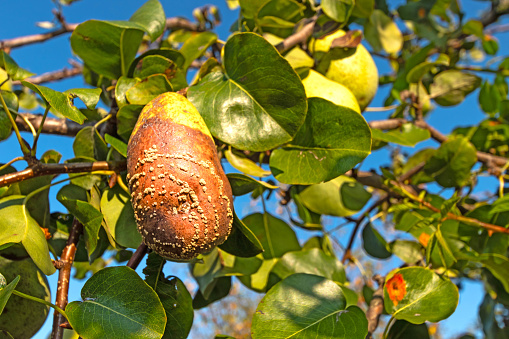Written by Admin and published on https://www.bioadvanced.com/
Fruit trees are a great asset to any garden or landscape. They provide shade, flowers, a yearly harvest, and a great talking point. They can also be very vulnerable to disease. Keep reading to learn more about the identification of fruit tree diseases and fruit tree disease treatments.
If you maintain any pitted fruit trees such as plums, peaches, or cherries, I’m sure you know that those types of trees are much more susceptible to diseases than any other type. While the fruits are delicious, it can be rather hard to live with all of the maladies that can plague the life of everyone who has ever grown one of those types of fruit trees.
Tree Care: Preventing Fruit Tree Diseases
Food gardening is more popular than ever. From harvesting edibles with incredible flavor to just simply knowing where your food comes from, the joys of “growing your own” are undeniable. But its also true that growing your own food is more challenging that just about any other type of gardening, especially when it comes to growing your own fruit.
To produce a quality harvest, fruit trees need some special care, particularly when it comes to controlling diseases. And that’s where you can help. Fruit diseases like brown rot, scab and fire blight can turn the best laid plans into a totally fruitless experience. Here are some problems you can expect and how to avoid them.
Know The Local Problems
Fruit diseases can be extremely regional. Check with your local Cooperative Extension System office for which ones are most troubling in your area. They can provide you with latest information on disease outbreaks, variety adaptation and proper timing of control measures (many states publish fruit tree maintenance calendars which are tremendously useful).
Plant Well-Adapted Varieties
Fruit tree adaptation is also very regional. Varieties and types that are well-adapted to your area should produce the best quality fruit and also offer better resistance to the most common diseases.
- Apples like Liberty, Redfree and Enterprise resist Scab, Mildew, Cedar Apple Rust and Fire Blight.
- Honeysweet and Kieffer are two of several pears that resist Fire Blight. Many Asian pears also resist Fire Blight.
- Although they might not offer the quality of some of the best peaches, Q 1-8 and Frost are resistant to Peach Leaf Curl.
- And there are many more disease-resistant fruit varieties.
- Because dwarf fruit trees are easier to maintain and spray, they are also good options where diseases are challenging. Some rootstocks provide resistance to soilborne diseases.
Proper Growing Conditions
Most fruit trees need full sun for at least 6 hours a day, well-drained soil, regular water and proper fertilization to produce quality crops. Too much shade, overwatering, poorly drained soils and too much nitrogen can promote disease. Fruit thinning is necessary to obtain acceptable fruit size in most tree fruit. It’s also a good chance to remove infected fruit that may spread disease. Choosing the proper planting site and providing the right care will go a long way to ensure a successful harvest.
Timely Pruning
Proper pruning opens trees to air circulation, drying and light, which can help prevent many diseases. It also removes diseased branches, preventing further infection. When you prune can be as important as how you prune. Most pruning is done during the dormant season, but summer pruning helps control tree size, encourages air circulation and is also a good time to remove diseased plant parts. Pruning during dry weather can also prevent the spread of disease. In California, for example, apricots are pruned in summer to prevent Eutypa Dieback, which can be spread through pruning cuts by winter rains. With some diseases, including Fire Blight, it’s important to sterilize shears with a 10% bleach solution after each cut.
Sanitation
Raking up and discarding dropped leaves and prunings, along with removing mummies (unpicked fruit) from trees, goes a long way in disrupting disease cycles from year to year.
Control Vectors
Not many fruit tree diseases are transmitted by insects, but there is one very important exception: the Asian Citrus Psyllid (ACP) and Citrus Greening Disease (known as Huanglongbing or HLB in the West). Controlling ACP is critical in controlling this devastating citrus disease, which has no cure. There are quarantines in place in primary citrus-growing states such as Florida and California. The insect threatens citrus in all citrus growing regions.
Protection From Insects
Controlling diseases of fruit trees usually takes multiple approaches, including fungicidal or bacterial sprays. Proper timing of these sprays is critically important. Dormant sprays can help control insects and disease in winter. A drench product like BioAdvanced™ Fruit, Citrus & Vegetable Insect Control* provides season-long protection without spraying and kills ACP. Always be sure to read and follow label instructions.
Original post here https://www.bioadvanced.com/articles/tree-care-preventing-fruit-tree-diseases/.


